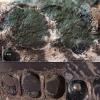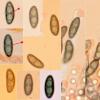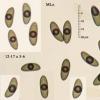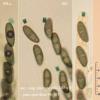
26-12-2025 21:19
Arnold BüschlenPithyella chalaudii Priou. Ist als Bryoparasit in

21-12-2025 09:32
Hello.A tiny ascomycete found embedded in wood in

18-12-2025 21:17
Pol DebaenstThe identification took me to Byssonectria deformi

24-12-2025 17:08
Hulda Caroline HolteHello, I have found this propoloid ascomycete on

21-12-2025 21:32
Pol DebaenstHello, Garden, Burgweg 19, Veurne, BelgiumOn 10/1
I need your help for to know this Nemania species that grew on the underside of a piece of wood of Salix alba in a very wet place periodically covered by the water of a lake.
The blackish multiperitheciate stromata are crust of 50 x 25 mm and 1 mm thick covered by a mass of olivaceous fresh discharged ascospores. Ostioles conspicually papillate. The perithecia are ellipsoid and 0.45-0.70 mm long. The tissue beneath the perithecial layer is whitish, soft,extending into the wood.
The asci are long stipitate, 180-207 x 8 microns, pars sporifera 98-107. The apical apparatus is IKI and Mlz. deep blue. Fresh ascospores, 12-17 x 5-6, are brownish olivaceous and they have a short, inconpicuous germ slit probably situated on the more convex side.
I think this fungus is close to Nemania aenea var. macrospora or the Nemania sp. leg. J. Vivant from the wonderfull Fournier's web page.
Have you any idea?
Thanks again

I find the germ slits on your photos fairly conspicuous, in my experience they are difficult to make out in the variety macrospora. I think it is the typical variety aenea, other features fit well, especially the ecology. Occurrence on periodically submerged wood is something I observed on several occasions for this species.
Anyhow I suggest you compare it with the typical aenea, I am sure you have it in your herbarium!
Cheers,
Jacques
No. I have not Nemania aenea var. aenea in my herbarium because I have never gathered it!
Yes. Maybe you are right and of course you know well this genus, much better than me!
Perhaps the subjective concept of the germ-slit: conspicuous/inconspicuous did me to be wrong.
Your description at the web page says: 'Macroscopically, N. aenea is much like N. serpens, with which it is easily confused' and in this case it is true because in the field I took it by Nemania serpens.
Thanks a lot again!





